
Journal of Fiber Science and Technology
Scope & Guideline
Shaping the Landscape of Fiber Science
Introduction
Aims and Scopes
- Fiber Material Properties and Performance:
Research on the mechanical, thermal, and chemical properties of various fiber materials, including natural, synthetic, and composite fibers, to understand their performance in different applications. - Innovative Fiber Processing Techniques:
Exploration of advanced processing methods such as electrospinning, wet spinning, and chemical treatments to enhance fiber functionalities and create novel fiber structures. - Functional and Smart Textiles:
Development of textiles with enhanced functionalities, such as moisture management, antibacterial properties, and environmental responsiveness, addressing modern consumer needs. - Environmental Impact and Sustainability:
Investigations into eco-friendly practices in fiber production and processing, including the use of sustainable materials and methods that reduce environmental impact. - Applications in Healthcare and Safety:
Research focusing on the application of fiber materials in healthcare, personal safety, and protective clothing, emphasizing their role in enhancing user comfort and safety.
Trending and Emerging
- Nanofiber Technology and Applications:
There is a significant increase in research focusing on nanofibers, including their production methods and diverse applications in filtration, wound dressings, and environmental remediation, showcasing their potential in advanced materials. - Smart Textiles and Wearable Technology:
Emerging research on smart textiles that integrate electronic components and sensors demonstrates an increasing interest in developing fabrics that respond to environmental stimuli, enhancing user experience and functionality. - Biopolymer and Eco-Friendly Fibers:
A growing body of work is focusing on sustainable fiber materials derived from biopolymers and natural sources, reflecting a broader trend towards environmentally conscious materials in the textile industry. - Functionalization of Fibers for Specific Applications:
Research is increasingly centered on the functionalization of fibers for targeted applications, such as antibacterial treatments and moisture management, highlighting the demand for specialized textile solutions. - Interdisciplinary Approaches in Fiber Science:
The integration of disciplines such as materials science, biology, and engineering is becoming more pronounced, indicating a trend towards collaborative research that enhances the understanding and application of fiber materials.
Declining or Waning
- Traditional Dyeing Techniques:
Research related to conventional dyeing methods has decreased as emphasis shifts towards more sustainable and innovative dyeing processes that utilize natural extracts or environmentally friendly chemicals. - Basic Fiber Mechanics:
While foundational studies on fiber mechanics were once prevalent, there has been a noticeable decline as the focus moves towards more complex interactions and applications of fibers in advanced materials. - Standard Testing Methods:
The frequency of publications centered around traditional testing methods for fiber properties has waned, likely due to the emergence of more sophisticated, integrated approaches that combine multiple testing parameters. - Single-Fiber Studies:
Research focusing solely on single-fiber characteristics is becoming less common, as there is a growing trend towards studying fiber composites and multi-fiber interactions for more comprehensive insights.
Similar Journals
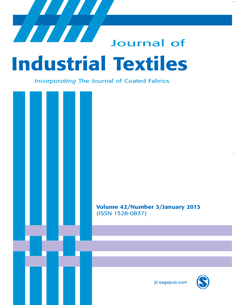
Journal of Industrial Textiles
Exploring the Future of Textile InnovationJournal of Industrial Textiles, published by SAGE Publications Inc, is a leading academic journal that focuses on the intricate interplay between textile materials and industrial applications. With a significant impact factor and a strong reputation in the field, it caters to a diverse audience ranging from researchers and professionals to students interested in the advancement of textile engineering, chemical engineering, and materials science. The journal offers invaluable insights into innovative textile processes, sustainable practices, and the latest technological developments as it spans research contributions from 1971 to the present. Notably, it ranks in the second quartile across various categories, including Chemical Engineering and Industrial and Manufacturing Engineering, reflecting its influence and quality in the scientific community. Although it is not an open access journal, the Journal of Industrial Textiles remains a critical resource for advancing knowledge and fostering collaboration within the textile sector and related fields.

FIBRE CHEMISTRY
Advancing the Science of Fibres for Tomorrow's Innovations.Fibre Chemistry is an esteemed journal published by Springer, focusing on the intricate and evolving field of polymer science and textile engineering. With its ISSN 0015-0541 and E-ISSN 1573-8493, this journal serves as a pivotal resource for researchers, practitioners, and students, highlighting significant advancements and innovations in fibre technology since its inception in 1969. Despite its current positioning in the Q3 quartile across Chemical Engineering, Chemistry, and Materials Science categories, Fibre Chemistry continually aims to bridge the gap between fundamental science and practical application by disseminating high-quality, peer-reviewed research articles. The journal does not currently operate under an open access model, but it provides crucial insights that foster collaboration and drive progress within its field. With the ongoing convergence of technologies and materials, this publication is poised to contribute significantly to the academic discourse surrounding fibre chemistry and its related disciplines until 2024 and beyond.

NORDIC PULP & PAPER RESEARCH JOURNAL
Innovating the Future of Forestry and Materials ScienceNORDIC PULP & PAPER RESEARCH JOURNAL (ISSN: 0283-2631; E-ISSN: 2000-0669) is a prestigious academic journal published by WALTER DE GRUYTER GMBH, situated in the heart of Berlin, Germany. This journal serves as a critical platform for interdisciplinary research within the field of forestry and materials science, with a notable impact factor reflecting its influence in both academia and industry. As a Q2 ranked journal in Forestry and a Q3 ranked journal in Materials Science according to the latest Scopus rankings, it provides a vital resource for professionals, researchers, and students alike. The journal covers a range of topics related to pulp and paper technology, aiming to advance knowledge, encourage innovation, and foster collaboration within these sectors. With its comprehensive and robust editorial approach, the journal is committed to delivering high-quality research that drives the understanding and development of sustainable practices in pulp and paper production. Although it does not currently offer open access options, its rich archive of research dating back from 1986 through to 2024 continues to be a significant asset for those in the field.

FIBERS AND POLYMERS
Transforming Ideas into Applications in Material ScienceFIBERS AND POLYMERS is a prestigious scholarly journal published by the Korean Fiber Society, specializing in the fields of Chemical Engineering, Chemistry, and Polymer Science. Since its inception in 2000, the journal has provided a dynamic platform for researchers and professionals to disseminate cutting-edge findings and innovative methodologies related to fibers, polymers, and their diverse applications. With its Q2 category ranking across multiple disciplines in 2023 and a commendable standing in Scopus rankings—ranking #183 in General Chemistry and #127 in General Chemical Engineering—it is well-regarded within the academic community. The journal’s commitment to quality research is further underscored by its comprehensive coverage of technological advancements and theoretical developments relevant to both industry and academia. Access to published articles may vary, and authors are encouraged to submit original research to contribute to this evolving field. Join the community shaping the future of materials science through FIBERS AND POLYMERS.
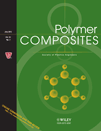
POLYMER COMPOSITES
Elevating Knowledge in Polymer SciencePOLYMER COMPOSITES, published by WILEY, is a leading journal dedicated to advancing the fields of materials science and engineering through the exploration of polymer composite materials. With its foundation dating back to 1980, this esteemed journal has continuously provided a platform for researchers to publish high-quality studies and innovative methodologies in areas such as ceramics, composites, and miscellaneous chemistry. Ranked in the prestigious Q1 quartile for sectors like Polymers and Plastics as well as Materials Chemistry, POLYMER COMPOSITES stands significant within the academic community, holding a notable impact factor that reflects its influence. The journal encompasses a comprehensive range of topics, making it essential reading for professionals, researchers, and students aiming to stay at the forefront of developments in polymer science and composite technologies. Although it does not currently offer Open Access, readers can access its impactful publications through institutional or individual subscriptions, contributing to ongoing advancements in the field and facilitating the exchange of valuable knowledge among scientists and engineers worldwide.
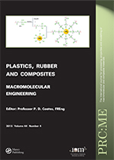
PLASTICS RUBBER AND COMPOSITES
Pioneering Research in Plastics and RubberPLASTICS RUBBER AND COMPOSITES is a leading academic journal published by SAGE Publications Inc., dedicated to advancing the understanding and application of polymers, plastics, and composite materials. With an ISSN of 1465-8011 and an E-ISSN of 1743-2898, this quarterly publication attracts a diverse readership from the fields of ceramics and composites, chemical engineering, materials chemistry, and polymer science. Currently indexed in the Q3 category across multiple relevant domains, the journal provides a platform for high-quality research and innovations that contribute significantly to material science. The journal's commitment to disseminating cutting-edge research makes it a valuable resource for researchers, industry professionals, and students who are eager to explore the latest developments and applications in this dynamic field. Despite its current non-open access status, the journal's rigorous peer-review process ensures that all published articles meet the highest academic standards, thus reinforcing its reputation as an essential source for scholarly work in the materials sector.
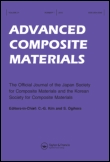
ADVANCED COMPOSITE MATERIALS
Driving Innovation in Composites and CeramicsADVANCED COMPOSITE MATERIALS, published by Taylor & Francis Ltd, is a leading peer-reviewed journal in the field of materials science, specifically focusing on the innovative development and applications of composite materials. With an ISSN of 0924-3046 and E-ISSN 1568-5519, this journal serves as a vital resource for researchers and professionals worldwide, examining cutting-edge advancements and methodologies in composites, ceramics, and mechanical engineering. Having secured a solid standing in the academic community, it boasts impressive Scopus rankings, such as #185 in Mechanical Engineering with a 72nd percentile and #46 in Ceramics and Composites, emphasizing its relevance and rigor. Although not an open-access publication, its insights are invaluable for those looking to explore, contribute to, and stay abreast of the latest breakthroughs in the field from 1991 through 2024. By targeting critical areas within mechanics and material sciences, the journal continues to foster innovation and scholarly discussion, making it an essential venue for specialists striving to advance the capabilities and applications of composite materials.

Fibers
Transforming Research into Real-world ApplicationsFibers is a leading peer-reviewed open access journal published by MDPI, focusing on cutting-edge research within the realm of materials science, particularly in the domains of biomaterials, ceramics and composites, and structural engineering. Established in 2013, the journal has gained recognition for its significant contributions to the field, boasting an impact factor that positions it in the Q2 quartile across multiple categories such as Biomaterials, Ceramics and Composites, Civil and Structural Engineering, and Mechanics of Materials as of 2023. With a Scopus ranking that highlights its prominence—such as in the top 20% in Civil and Structural Engineering—the journal fosters an inclusive platform for academic dialogue and technical advancement. Researchers and professionals can access the journal’s comprehensive articles freely, promoting the dissemination of knowledge that is crucial for the advancement of innovative materials and their applications. Situated in Basel, Switzerland, Fibers continues to be an essential resource for those looking to stay at the forefront of research and technology in material sciences.
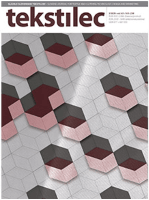
Tekstilec
Innovating textile solutions for a dynamic industrial landscape.Tekstilec, an esteemed journal published by University of Ljubljana, Slovenia, has been a prominent platform in the fields of textiles, engineering, and industrial management since its establishment in 1989. With an Open Access model since 2000, the journal ensures that scholarly research is accessible to a global audience, fostering the dissemination of knowledge across various disciplines. While its impact factor remains unlisted, Tekstilec holds respectable rankings within its categorized quartiles, featuring a 2023 Q4 ranking in Business and International Management and Q3 rankings in multiple engineering and material science categories. This positions the journal as a vital resource for researchers, professionals, and students seeking insights into textiles and their multidisciplinary applications. With a commitment to advancing knowledge in its scope, Tekstilec invites contributions that explore innovative research and practical developments, encouraging collaboration within the global academic community.
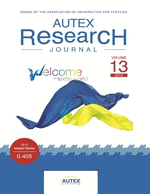
Autex Research Journal
Exploring the future of textiles and technology for a global audience.Autex Research Journal is a distinguished *open access* academic journal published by WALTER DE GRUYTER GMBH, specializing in the interdisciplinary fields of Industrial and Manufacturing Engineering, Management of Technology and Innovation, and Materials Science. Since its inception in 1999, the journal has fostered scholarly communication by offering a platform for innovative research and advancements in textile technology and related disciplines. With an impact factor indicative of a solid academic reputation, the journal holds a prestigious Q3 quartile ranking in multiple categories, including Industrial and Manufacturing Engineering and Management of Technology and Innovation, positioning it as a noteworthy resource for both researchers and practitioners. The journal embraces a global perspective, featuring a broad scope of topics pertinent to textile science, innovation management, and material application in various industries. Its open access format since 2012 ensures that the latest research is freely available to a wide audience, reinforcing its commitment to the advancement of knowledge and technology in textiles. Researchers, professionals, and students alike will find the *Autex Research Journal* an invaluable resource for staying updated on developments within these dynamic fields.